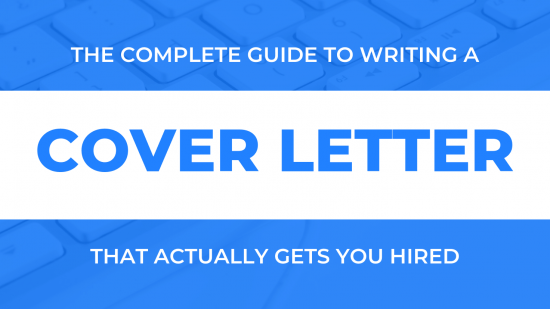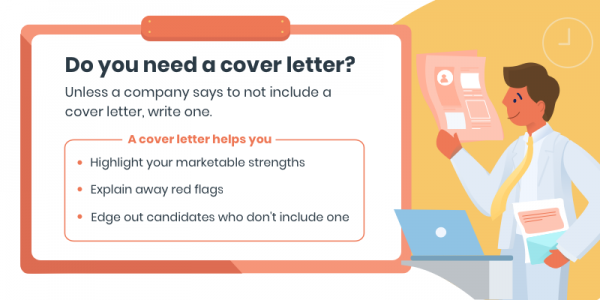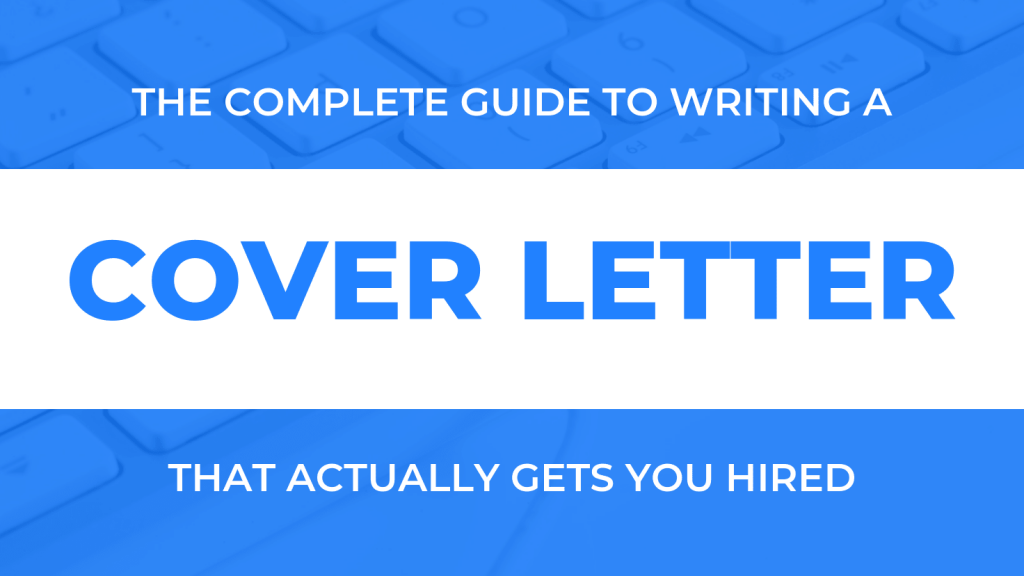How To Write a Successful Cover Letter – Step By Step Guide
Knowing how to craft a cover letter is an essential aspect that can land you a job. However, not everyone is conversant with the best strategies for composing it. In this article, you will get insightful information on how you can write a cover letter. Let’s go!
What is a Cover Letter?
A cover letter is an official document that you use to showcase your profile and achievements to your hiring managers. With this piece, you can state who you are and what you are likely to bring to the organization if you are allowed to work there.
How to Write a Cover Letter
A cover letter is a short piece, not more than a page, which you submit as part of job application requirements. The essence of this document is to summarize your professional profile and introduce you to your prospective employer.
Writing an excellent cover letter can evoke the recruitment manager’s interest in reading your resume. It is vital to note that a cover letter is meant to complement your resume, and, therefore, it is advisable not to repeat your CV’s content in it.

The Structure of a Cover Letter
The following is an overview of the components of a cover letter.
-
Cover letter header
Being aware of how to head a cover letter is a crucial aspect of your job search. In the header, you are supposed to include your employer and your contact information. These details include names, addresses, and phone numbers.
-
Salutation
Salutation is an official greeting that you provide in the cover letter. If you are unsure of the hiring manager’s gender, address them as “Dear Hiring Manager” instead of “Dear sir or Dear Madam.”
-
Introduction
Your introduction must be exciting to hook the reader’s attention. Start your opening by highlighting the job you are applying for and mention where you heard it. In this section, it is vital to show how your skills and experience match the job you are applying for.
-
Body
Under this section, justify why you are interested in the position, and convince the employer why you are the best fit for the role. For instance, you may mention specific requirements in the job and demonstrate how you meet those conditions.
Tell the hiring manager who you are by using examples from your previous assignments. Supporting the information you provide is one of the best strategies you can use to make your cover letter more unique than those of your competitors.
-
Conclusion
The conclusion is the closing of your cover letter. In this section, restate how your skills and experience match for the job. Also, highlight the reasons that make you want to work in the company.
Moreover, show your employer that you are eager to be invited for the interview to have a further discussion on the position.
-
Signature
Before you append your signature, it is crucial to ending your letter with a complimentary close, such as “Yours Sincerely” and “Yours faithfully.” If you are crafting a hand-written cover letter, send it with your signature, followed by your typed name. However, if you are crafting an email-based cover letter, write your name and then finish with your contact information.
Writing a Cover Letter for a Professional Job
Writing a cover letter for a professional job isn’t a straightforward thing, especially when you are inexperienced. If you are crafting a cover letter for a professional job, it is advisable to do the following: creating an appropriate header, use the right salutation to address the hiring manager, introduce yourself properly, and show the employer that you can help them meet their needs.
Basic Cover Letter Layout
Basic cover letter layout entails the way words are distributed on the page, spacing, font, and heading. Ensure you use a format that makes your letter professional and easy to read. Before you send your application, it is essential to ensure that the layout of your cover letter is well-spaced. For instance, make sure that there is the right space between the heading, salutation, introduction, body paragraphs, and signature.
The following is a description of how you can layout your cover letter.
-
Contact information
The first part of your cover letter should have your address and your employer’s. Your contact details are essential to enable the hiring manager to communicate to you if your application is successful.
Ensure that the contact information is justified to the left and single-spaced. Also, make sure that there is a pace separating your contact information from that of the employer.
-
First paragraph
Ensure that all your body paragraphs are single-spaced with a space between each paragraph. The first paragraph should capture the details of the position you are applying for, such as the working title. Also, you should indicate how you learned about the opportunity and justify why you are the right candidate for it.
-
Middle paragraphs
In these sections, highlight what you will offer your employer. Mention why you think your skills and experience match the position you are applying for. Moreover, you may provide specific examples to support your experience.
-
Closing paragraph
Finalize your cover letter by appreciating the employer for allowing you to apply. Also, mention how you will follow-up with the hiring manager to get information on the application status.
-
Complimentary close
A complimentary close is a phrase that comes between the closing paragraph and the signature sections of the cover letter. Ensure that there is a space between the conclusion and the close. The purpose of a complimentary close is to show regards to your employer. Ensure that you use an official complimentary end like “Yours sincerely.”
-
Signature
The signature is the last section of your cover letter. By signing, you confirm that the content in the document is credible. Note that the signature may be hand-written if you are mailing or hand-delivering the letter.
How Long Should a Cover Letter Be?
It is vital to note that a cover letter is an official document that you use to present your qualifications to convince the employer that you are qualified for the position. A cover letter ought to be a one-page document of 250-275 words.
Different Types of Cover Letters
There are three types of cover letters, and they include the application letter, networking letter, and prospecting letter. The following is brief descriptions of these documents
-
Application letter
An application letter is a piece that you use to apply for a particular job opening.
-
Networking letter
With a networking letter, you can seek and get help in your job search.
-
Prospecting letter
A prospecting letter is used to inquire whether some positions are available with a particular employer.

What to Include in Your Cover Letter
A cover letter is meant to complement but not duplicate your resume. The essence of this piece is to give more details to your employer regarding recruitment. You should bear in mind that a cover letter ought to be written well because it gives the hiring manager the first impression of you.
The following are brief descriptions of the components of an excellent cover letter.
-
Proper contact information
Contact information is crucial to enable the employer to communicate with you about the status of your application. The first section of your cover letter includes your name, address, phone number, and email address. It is also advisable to include your LinkedIn address to enable the employer to have access to your profile. Also, note that the employer’s contact information is included in the cover letter, especially when you are submitting it through hand or mail.
It is vital to note that there is a difference in how the contact details appear on a printed and email cover letters. For the former, the contacts appear as the first information between header and salutation. However, for the latter, your contact information is included after the signature.
-
Use the right salutation
When crafting a cover letter, it is vital to use the right information to greet the person you are addressing. For instance, if possible, address your contact person by their name. The following salutations are recommended: “Dear Hiring Manager” or “Dear Mr. Enock.”
It is advisable to research the name of the hiring manager instead of using general salutations, such as “Dear Sir/Madam.”
-
Body paragraphs
Knowing how to write a body of a cover letter is crucial to job seekers. The body is an essential section of the cover letter where you showcase your skills to confirm to your employer that you are the most suited candidate for the job. In this section, you are supposed to demonstrate your qualification, experience, and appreciation for being considered for the opportunity.
As a job seeker, it is essential to familiarize yourself with what goes in a cover letter. The following is a description of what is included in different body paragraphs.
-
First paragraph
Use this section to highlight the position you are applying for and make it exciting to grab your reader’s attention. It is vital to give brief information about your skills and experiences to enable the employer to understand you better.
-
Second paragraph
In this section, show what you will offer your employer. Moreover, it is vital to confirm to the employer about your previous experience by using examples. You may use bulleted points to attract the attention of your audience to your achievements.
-
Third paragraph
Showcase your knowledge about the employer by demonstrating that you know their business, and you can help them achieve their mission.
-
Closing paragraph
Before you craft this part, you should ask yourself, “What should the final paragraph of a cover letter include?” Conclude on what you will do for the organization, and suggest a meeting or a call to know the status of your application
-
Use keywords
It is vital to use keywords related to the job you are applying for. Note that the hiring manager looks for such words/phrases before they shortlist candidates for the position. Currently, online hiring is automated, and unique programs are used to search for keywords.
-
Use an appropriate closing
Appropriate closing is a critical aspect of finishing the crafting of your cover letter. Ensure you close your letter professionally by using phrases such as “Yours faithfully,” and avoid using casual statements like “Best regards.”
-
Add your signature to the cover letter
The kind of signature you use depends on whether you are emailing, uploading, or sending the letter as an email. It is advisable to sign hard copies using your hand, and the email cover letter should bear professional signatures that encompass your contact details.
What Not to Include in Your Cover Letter
Knowing how to write an effective cover letter can quickly land you a job. Therefore, it is vital to keep your cover letter concise to enhance your success. It is advisable to avoid making exaggerations and stick to giving only brief and relevant information as per the job description.
Cover Letter Parts
If you are composing a cover letter for a job, it is essential to ensure that all the crucial elements are included to maximize the chances of getting hired. A professional cover letter should have the following sections: contact information, body, conclusion, and signature.
The Purpose of a Cover Letter
The essence of a cover letter is to introduce yourself to an employer, show reasons why you should be hired, attract the hiring manager’s interest to your resume, and motivate the employer to invite you for the interview.
Guidelines for Effective Cover Letter Writing
The following is a highlight of the tips that you can use to craft an excellent cover letter.
-
Use a business letter format
A business letter format commonly uses the ‘block style’ where the entire document is justified left. Under this approach, the text is single-spaced, but a double-space is placed between paragraphs.
-
Personalize each letter
Each letter should be addressed to a specific person within the organization. It is crucial to research and get the appropriate contact details for your employer.
-
Use a professional language
If you are not sure of the name of the specific person you are applying to, do not use salutations such as “Dear sir” or “Dear Madam.” Instead, use general greetings like “Dear hiring manager.”
-
Limit the content of your letter to one page
An excellent cover letter ought to be clear and concise. Ensure that you use a few words to express everything required in the job description. Note that cover letters are always less than a page and not more than five paragraphs.
-
Don’t overuse the word “I”
The cover letter must be conversational, and you should always use the word “you” as opposed to “I”. For instance, instead of saying, “I have enclosed a copy of my certificate,” say, “enclosed, please find a copy of my certificate.”
-
Make your text easy to read
To make your writing easy to read, use short sentences that make sense to your audience. Also, it is advisable to use transitional words to make the ideas in your letter flow smoothly.
-
Use action verbs and adjectives
If you want to introduce yourself appropriately to your employer, use action verbs to describe your qualification and experience.
-
Proofread and edit your cover letter
After crafting your cover letter, it is vital to read it through to check for any spelling or grammatical errors. Besides using a grammar checker, it is crucial to go through it to detect mistakes that the software might not identify.
How to Match a Cover Letter to the Job
The content in your cover letter should reflect the level of understanding of the position you are applying for. It is advisable to be to show how your skills and experience match the job on offer.
The following is a highlight of the things you can do to make your cover letter match the job.
-
Find out the person to address
Getting a specific person to address your letter is crucial for your application. If the details of the person are not included in the advertisement, contact the employer via phone or email to get them.
-
Research more about the job
You can get further details regarding the advertised job from the employer. The following is the information you should ask for: whether the position involves teamwork, the person to report to, and the job description.
-
Find out more about the company
If you want to match your application to the job, you must get adequate information about the organization. Note that the crucial details that you need to know include: the name of the company, its mission, whether it has a website, and its vision.
Final Thoughts on How to Write a Cover Letter
A cover letter is a vital document that you use to introduce yourself to the hiring manager to draw their attention to your resume and motivate them to invite you for the interview. An excellent cover letter must have an introduction, body paragraphs, conclusion, and signature. If you not conversant with composing these pieces, contact Peachy Essay writers for Cover Writing Help.




